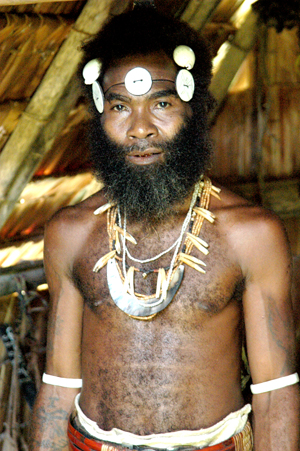“Solomon Islands Mysteries” is a book taken seriously
by some crypto-zoologists, but it's actually a very extreme work. The author,
Marius Boirayon, has ideas similar to those of David Icke and has previously
published his work in Nexus, an Australian magazine devoted to various
conspiracy theories. Boirayon is an Australian pilot, explorer and businessman.
He spent a large portion of his life in Papua New Guinea and the Solomon
Islands.
In his book, Boirayon argues that the Solomon Islands are home to several races
of giants and aliens. He recounts local folklore about the giants, a kind of
ape-men who seem to be much larger, more human-like and far more dangerous than
Bigfoot. While Boirayon hasn't observed any giant himself, he has made a number
of UFO observations. The Solomon Islands UFOs are associated with the sea and
certain mountain lakes, and are regularly observed by the locals. So far,
nothing out of the ordinary: “giants” and UFOs are seen all over the world,
especially the latter!
Unfortunately, Boirayon then spins a web of conspiracy theories around these
stories and observations, making the book progressively less believable as it
unfolds. He claims that the mysterious lights seen at the islands are
mechanical craft manned by an alien civilization, the denizens of which has
lived in bases below the Earth's surface for millennia. The “aliens” aren't
really from outer space, but represent an intelligent species evolving here on
Earth, which for various reasons have gone literally underground. They have a
vast network of tunnels and secret bases all around the world. Some of these
creatures are reptilian in shape. The giants, by contrast, are surface-dwelling
primates, but at some point, they became subjected to the “alien” power. The
Australian intervention at the Solomon Islands in 2003, ostensibly to stop
ethnic violence at the main island of Guadalcanal, was really a move by the
secret One World Government cabal to stop the author from exposing the truth
about the aliens and giants! Boirayon also claims to have discovered that the
islands have such large quantities of oil, gas and precious gemstones that the
world market prices would collapse in the event of commercial extraction.
Therefore, the Cabal has to take control of these resources and stop them from
being exploited until such a time that they can become profitable. Above all,
they have to stop the whistle-blower, Marius Boirayon himself. According to the
author, all his evidence (including UFO photos) was forcibly taken from him by
Australian secret agents…
I admit that Boirayon is a good writer and that “Solomon Islands Mysteries”
does give you an interesting (and frequently absurd) look at the life in this
small nation. The book is eclectic and contains folkloristic material, UFO
conspiracy speculations and personal anecdotes about everything from corrupt
local politicians to tribal ceremonies. Indeed, Boirayon is something of a
“gonzo journalist”, since he frequently inserts himself into the story. If you
like Jon Ronson, you may find this to your liking.
That being said, as a reader interested in crypto-zoology and the occult, I
obviously want to know how much of this material is really true? That is, how
much is based on actual reports about paranormal activity, and how much is the
product of the author's own fertile imagination. Some claims are manifestly
bogus. Thus, Boirayon claims that the Japanese war memorial at Guadalcanal
shows a reptile-like creature with a ray gun, and cites this as evidence for
the Japan knowing the truth about the “aliens”. However, a quick search on the
web reveals that the statue (and it is the old statue, not the recent
replacement) shows a completely ordinary human fisherman. In another chapter,
Boirayon retells a story about an abandoned woman and her two sons confronting
a giant, an event which supposedly happened during the 19th century. However,
the same story is known from all over Melanesia in slightly different versions
and is really a mythological motif. At New Ireland, north of the Solomon
Islands, the “giant” killed by the two brothers is a monstrous pig! I get the
impression that the author may have misinterpreted a myth as a real historical
event. The underground civilization is another common myth, but also surfaces
in science fiction (compare “The Shaver Mysteries”). Boirayon wonders why the
natives refer to the subterranean world as “Mu Mu”, which sounds much like Mu,
the lost continent in the Pacific proposed by James Churchward. Unfortunately,
it sounds even closer to the trolling British pop band the Justified Ancients
of Mu Mu, inspired by the Discordian Illuminatus Trilogy! While none of this
necessarily disproves Boirayon's claims (legends can be based on true events,
after all), it does raise some red flags.
The part of the story dealing with “UFOs” or orbs is easiest to accept, at
least for me. Weird phenomena of this kind have been observed all over the
world (most famously in Hessdalen, Norway). The giants are more difficult to
accept, since they are supposedly ubiquitous and extremely large. Why haven't
they been seen, caught or killed by outsiders? But the “hard to believe award”
surely goes to the claim about a worldwide conspiracy directed at one single
individual, the gonzo journalist himself. By all means, read this book. It's
not bad. However, I don't think it reveals the truth about the Solomon Islands
mysteries…


